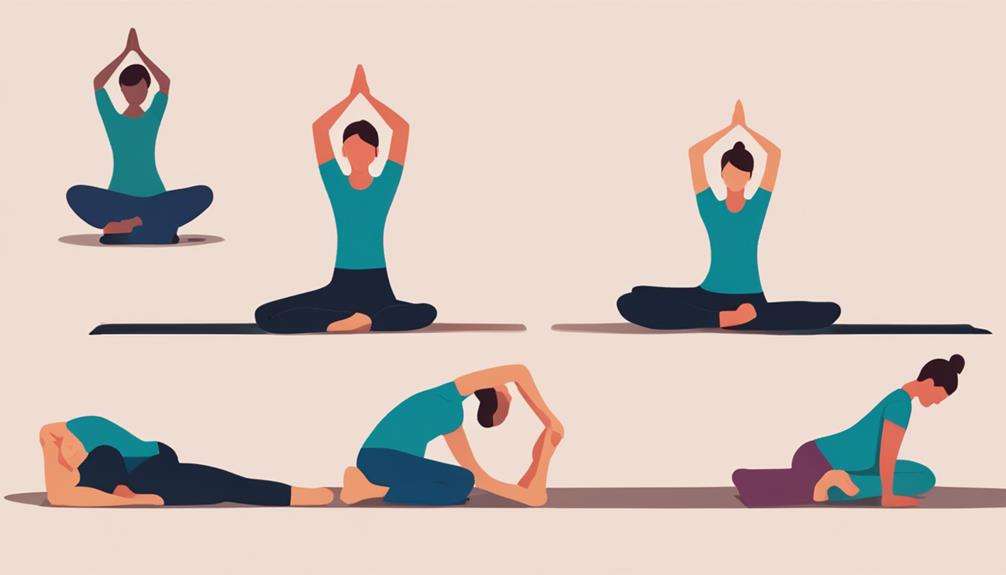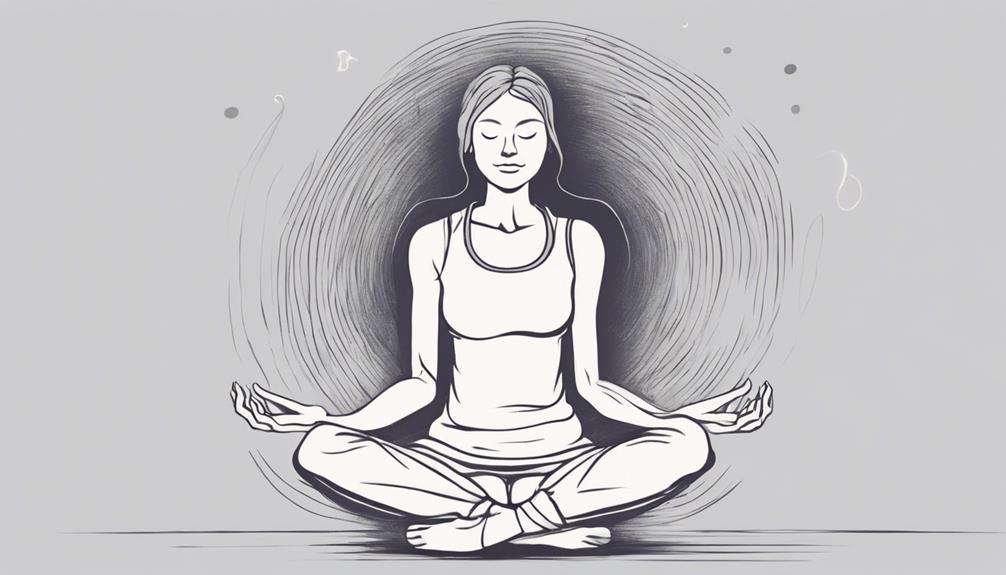Did you know that the combination of yoga therapy and meditation techniques can offer a holistic approach to managing chronic pain?
Exploring the interconnectedness of mind and body, this guide provides a unique perspective on pain relief that goes beyond traditional methods.
By uncovering the transformative power of yoga poses, mindfulness practices, and breathwork, you can discover a new path towards sustainable pain management.
Key Takeaways
- Yoga therapy and meditation offer holistic pain relief.
- Personalized plans cater to individual needs for effective pain management.
- Mindfulness practices enhance emotional well-being and pain resilience.
- Integrating yoga and meditation promotes long-lasting healing and improved quality of life.
Understanding Chronic Pain and Yoga
If you struggle with chronic pain, exploring the connection between yoga and pain management can offer you a holistic approach to improving your well-being. Chronic pain affects many individuals globally, impacting their quality of life and overall well-being. Yoga, known for its holistic healing properties, provides physical and emotional pain management through various practices such as breathing techniques and specific yoga poses.
Yoga not only helps in managing chronic pain but also addresses both the physical and emotional facets of pain. Through yoga, you can experience increased flexibility, reduced stress levels, and an overall sense of balance. Poses like Cat-Cow, Child's Pose, and Mountain Pose are specifically beneficial for chronic pain relief. Additionally, breathwork techniques like Pranayama, Ujjayi breath, and Nadi Shodhana aid in pain management and promote mindfulness, helping you connect your body and mind in a healing way. By incorporating yoga into your routine, you can embark on a journey towards better pain management and improved well-being.
Benefits of Yoga Therapy for Pain
Exploring the benefits of yoga therapy for pain management reveals a holistic approach that enhances overall well-being and quality of life. Yoga therapy offers a range of advantages for individuals dealing with chronic pain:
- Physical Exercise: Engaging in yoga therapy provides a gentle yet effective form of physical activity, aiding in improving flexibility, strength, and overall physical function in individuals with chronic pain conditions.
- Mental Health Benefits: The practice of yoga therapy promotes mental well-being by reducing stress levels, enhancing emotional resilience, and fostering a sense of calmness, which can be particularly beneficial for those experiencing persistent pain.
- Holistic Approach: Integrating yoga therapy into a comprehensive pain management strategy offers a holistic approach that addresses not only the physical symptoms but also considers the mental and emotional aspects of pain, leading to a more well-rounded and sustainable relief.
Yoga Poses for Pain Management

Incorporate these yoga poses into your routine to effectively manage pain and enhance flexibility and relaxation.
For chronic low back pain relief, consider practicing yoga therapy techniques that focus on gentle movements and proper alignment. Poses like Child's Pose, Cat-Cow, and Downward Dog can help reduce pain and increase flexibility in the spine.
Specific postures such as Cobra Pose and Bridge Pose target areas of tension, promoting healing and mobility. Breathing exercises integrated into yoga sequences aid in relaxation and stress reduction, contributing to overall health and well-being.
Emphasizing correct alignment in poses like Seated Forward Bend and Supine Twist can alleviate muscle tightness and discomfort associated with chronic pain. Regular practice of these yoga postures not only helps in reducing pain but also improves range of motion, making daily activities easier.
Mindfulness Meditation for Pain Relief
Transitioning from yoga poses for pain management, embracing mindfulness meditation can further deepen your journey towards holistic pain relief and well-being. Mindfulness meditation is a powerful practice that can positively impact your experience of pain. Here's why it can be beneficial for you:
- Mindfulness meditation alters brain activity linked to pain processing, reducing the perception of pain.
- Studies have shown that mindfulness meditation is effective in decreasing chronic pain intensity and enhancing overall quality of life.
- By cultivating body awareness and fostering a non-reactive attitude towards pain sensations, mindfulness practices enable you to observe pain without judgment, ultimately improving pain management.
Through regular mindfulness meditation, you can train your brain to respond differently to pain signals, offering you a valuable tool in your quest for holistic pain relief. Embracing mindfulness meditation as part of your pain management strategy can lead to reduced suffering and enhanced well-being.
Breathwork Techniques for Pain Relief

Embracing breathwork techniques in your pain management routine can significantly enhance your journey towards holistic relief and well-being. Utilizing pranayama, such as Ujjayi breath, can help regulate your nervous system and reduce your perception of pain. This slow and controlled breathing method not only calms your mind but also aids in effectively managing pain.
Nadi Shodhana, another breathwork technique involving alternate nostril breathing, promotes relaxation and balances your energy flow, ultimately alleviating pain. Deep breathing practices activate your parasympathetic nervous system, reducing stress levels and enhancing pain relief.
Integrating Yoga and Meditation for Pain
When it comes to integrating yoga and meditation for pain relief, you'll discover a powerful combination of physical poses and mental techniques.
Yoga poses can help alleviate physical discomfort, while meditation techniques enhance mental clarity and emotional well-being.
Yoga Poses for Pain
To alleviate chronic pain and cultivate a holistic approach to pain management, integrating yoga poses and meditation techniques is key. Incorporating gentle yoga poses like Cat-Cow, Child's Pose, and Mountain Pose can help relieve chronic pain by improving flexibility, strength, and blood circulation.
When combined with meditation, these poses enhance pain relief through relaxation and mindfulness, promoting a deeper mind-body connection. Additionally, practicing pranayama techniques such as Ujjayi breath can aid in managing pain perception and overall well-being.
Meditation Techniques for Relief
Integrating meditation techniques with yoga not only offers effective pain relief by reducing stress but also enhances relaxation, fostering a deeper connection between your mind and body. Mindfulness meditation, a key component of this integration, helps you become more aware of your body and emotions, aiding in the management of pain.
Studies have demonstrated that regular meditation practices can lower perceived pain intensity and increase pain tolerance over time. Incorporating deep breathing exercises into your meditation sessions can further alleviate physical tension and promote overall well-being.
Yoga Nidra for Pain Management

Wondering how you can effectively manage pain and enhance your well-being? Yoga Nidra, a guided meditation technique, could be the key to finding relief from chronic pain and improving your overall quality of life. Here's why Yoga Nidra is beneficial for pain management:
- Deep Relaxation: Yoga Nidra induces a state of deep relaxation, calming the nervous system and reducing the perception of pain.
- Targeted Pain Relief: Through a systematic process of relaxation, visualization, and body awareness, Yoga Nidra targets pain relief at a subconscious level.
- Enhanced Well-being: Research indicates that regular practice of Yoga Nidra not only reduces chronic pain but also enhances sleep quality and overall well-being.
Incorporating Yoga Nidra into your pain management routine can be a powerful tool for those dealing with conditions like fibromyalgia, arthritis, or back pain. By embracing this practice, you can pave the way for lasting relief and a more balanced life.
Holistic Approach to Pain Relief
Embracing a holistic approach to pain relief through yoga therapy and meditation can offer a transformative path towards healing and well-being. Yoga therapy takes into account the interconnectedness of physical, emotional, and mental well-being in addressing pain. By incorporating yoga postures, breathwork, meditation, and visualization techniques, individuals can alleviate pain and promote overall healing.
Personalized treatment plans crafted in yoga therapy cater to individual needs, goals, and health conditions, ensuring effective pain management strategies. This personalized approach not only reduces pain but also enhances resilience, decreases inflammation, and uplifts the quality of life, especially for those battling chronic pain.
Furthermore, integrating mindfulness practices into yoga therapy empowers individuals to cultivate self-awareness, break free from negative thought patterns, and bolster their emotional well-being. Embracing this holistic approach to pain relief through yoga therapy and mindfulness practices can pave the way for profound healing and improved quality of life.
Yoga Therapy for Specific Pain Conditions

In addressing specific pain conditions, yoga therapy offers tailored interventions that holistically target and alleviate pain while promoting well-being. Yoga therapy has been proven effective in reducing pain and disability associated with various conditions such as back and neck pain, fibromyalgia, migraines, and arthritis.
Studies highlight the positive impact of yoga therapy on mood enhancement, self-regulation, and stress reduction in individuals dealing with chronic pain. Specific yoga therapy techniques can directly address and alleviate pain related to musculoskeletal issues, ultimately enhancing overall well-being.
By incorporating mindfulness practices, yoga therapy equips individuals with tools to manage pain effectively, improve mental health, and enhance emotional well-being.
- Yoga therapy effectively reduces pain and disability in various conditions.
- Studies show positive effects on mood, self-regulation, and stress levels.
- Specific techniques target and alleviate pain associated with musculoskeletal issues.
Creating a Personalized Pain Relief Plan
Customizing your pain relief plan through yoga therapy involves tailoring interventions to address your specific needs, goals, and health conditions. By creating a personalized approach, yoga therapy can effectively alleviate pain, enhance mobility, and promote overall well-being. These individualized sessions integrate various techniques such as yoga postures, breath work, meditation, and relaxation practices designed to target and manage your specific pain issues. Through this holistic approach, the aim isn't only to reduce pain but also to address related concerns like stress and chronic health conditions.
The beauty of personalized pain relief plans in yoga therapy lies in their ability to offer sustainable and effective strategies for managing pain. By focusing on your unique requirements, these tailored interventions can help you develop a deeper understanding of your body and its responses, leading to long-lasting pain relief and improved quality of life. Embracing a holistic approach to pain management through personalized yoga therapy sessions empowers you to take control of your well-being and find relief in a mindful and compassionate manner.
Frequently Asked Questions
Can Meditating and Practicing Yoga Reduce Pain?
Yes, meditating and practicing yoga can reduce pain for you. By cultivating a strong mind-body connection, increasing breath awareness, and invoking the relaxation response, you can effectively manage pain and promote overall well-being.
What Are the 4 Areas of Pain That Yoga Can Help Manage?
In the realms of pain management, yoga works its magic like a soothing balm. It embraces the mind-body connection, eases pain perception, offers stress relief, enhances mobility, and brings muscle relaxation, paving the path to holistic well-being.
What Type of Yoga Is Best for Pain?
For pain relief, try restorative poses and gentle flows in yoga. Incorporate Yin yoga for deep tissue release, chair yoga for support, and alignment techniques for precision. These practices offer holistic healing and comfort.
How Yoga Cured My Chronic Pain?
You can't believe how yoga transformed your chronic pain! The mind-body connection, breath awareness, movement therapy, and holistic healing practices all worked together to shift your pain perception, leading to miraculous relief.
Conclusion
As you journey through the world of holistic pain relief with yoga therapy and meditation, remember that each pose, breath, and mindful moment is like a gentle rain shower nourishing the roots of a tree. Just as the tree grows stronger and more resilient with each drop, so too will your mind and body flourish with these practices.
Embrace the interconnectedness of your being and cultivate a garden of well-being within yourself.






